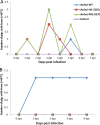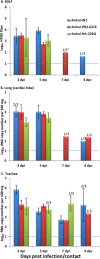Analysis of recombinant H7N9 wild-type and mutant viruses in pigs shows that the Q226L mutation in HA is important for transmission
- PMID: 24807722
- PMCID: PMC4097782
- DOI: 10.1128/JVI.00894-14
Analysis of recombinant H7N9 wild-type and mutant viruses in pigs shows that the Q226L mutation in HA is important for transmission
Abstract
The fact that there have been more than 300 human infections with a novel avian H7N9 virus in China indicates that this emerging strain has pandemic potential. Furthermore, many of the H7N9 viruses circulating in animal reservoirs contain putative mammalian signatures in the HA and PB2 genes that are believed to be important in the adaptation of other avian strains to humans. To date, the definitive roles of these mammalian-signature substitutions in transmission and pathogenesis of H7N9 viruses remain unclear. To address this we analyzed the biological characteristics, pathogenicity, and transmissibility of A/Anhui/1/2013 (H7N9) virus and variants in vitro and in vivo using a synthetically created wild-type virus (rAnhui-WT) and two mutants (rAnhui-HA-226Q and rAnhui-PB2-627E). All three viruses replicated in lungs of intratracheally inoculated pigs, yet nasal shedding was limited. The rAnhui-WT and rAnhui-PB2-627E viruses were transmitted to contact animals. In contrast, the rAnhui-HA-226Q virus was not transmitted to sentinel pigs. Deep sequencing of viruses from the lungs of infected pigs identified substitutions arising in the viral population (e.g., PB2-T271A, PB2-D701N, HA-V195I, and PB2-E627K reversion) that may enhance viral replication in pigs. Collectively, the results demonstrate that critical mutations (i.e., HA-Q226L) enable the H7N9 viruses to be transmitted in a mammalian host and suggest that the myriad H7N9 genotypes circulating in avian species in China and closely related strains (e.g., H7N7) have the potential for further adaptation to human or other mammalian hosts (e.g., pigs), leading to strains capable of sustained human-to-human transmission. Importance: The genomes of the zoonotic avian H7N9 viruses emerging in China have mutations in critical genes (PB2-E627K and HA-Q226L) that may be important in their pandemic potential. This study shows that (i) HA-226L of zoonotic H7N9 strains is critical for binding the α-2,6-linked receptor and enables transmission in pigs; (ii) wild-type A/Anhui/1/2013 (H7N9) shows modest replication, virulence, and transmissibility in pigs, suggesting that it is not well adapted to the mammalian host; and (iii) both wild-type and variant H7N9 viruses rapidly develop additional mammalian-signature mutations in pigs, indicating that they represent an important potential intermediate host. This is the first study analyzing the phenotypic effects of specific mutations within the HA and PB2 genes of the novel H7N9 viruses created by reverse genetics in an important mammalian host model. Finally, this study illustrates that loss-of-function mutations can be used to effectively identify residues critical to zoonosis/transmission.
Copyright © 2014, American Society for Microbiology. All Rights Reserved.
Figures








References
-
- WHO. 2009. Influenza (seasonal) fact sheet 211. http://www.who.int/mediacentre/factsheets/fs211/en/.
-
- Zhou J, Wang D, Gao R, Zhao B, Song J, Qi X, Zhang Y, Shi Y, Yang L, Zhu W, Bai T, Qin K, Lan Y, Zou S, Guo J, Dong J, Dong L, Zhang Y, Wei H, Li X, Lu J, Liu L, Zhao X, Li X, Huang W, Wen L, Bo H, Xin L, Chen Y, Xu C, Pei Y, Yang Y, Zhang X, Wang S, Feng Z, Han J, Yang W, Gao GF, Wu G, Li D, Wang Y, Shu Y. 2013. Biological features of novel avian influenza A (H7N9) virus. Nature 499:500–503. 10.1038/nature12379 - DOI - PubMed
Publication types
MeSH terms
Substances
Associated data
- Actions
Grants and funding
LinkOut - more resources
Full Text Sources
Other Literature Sources
Medical

